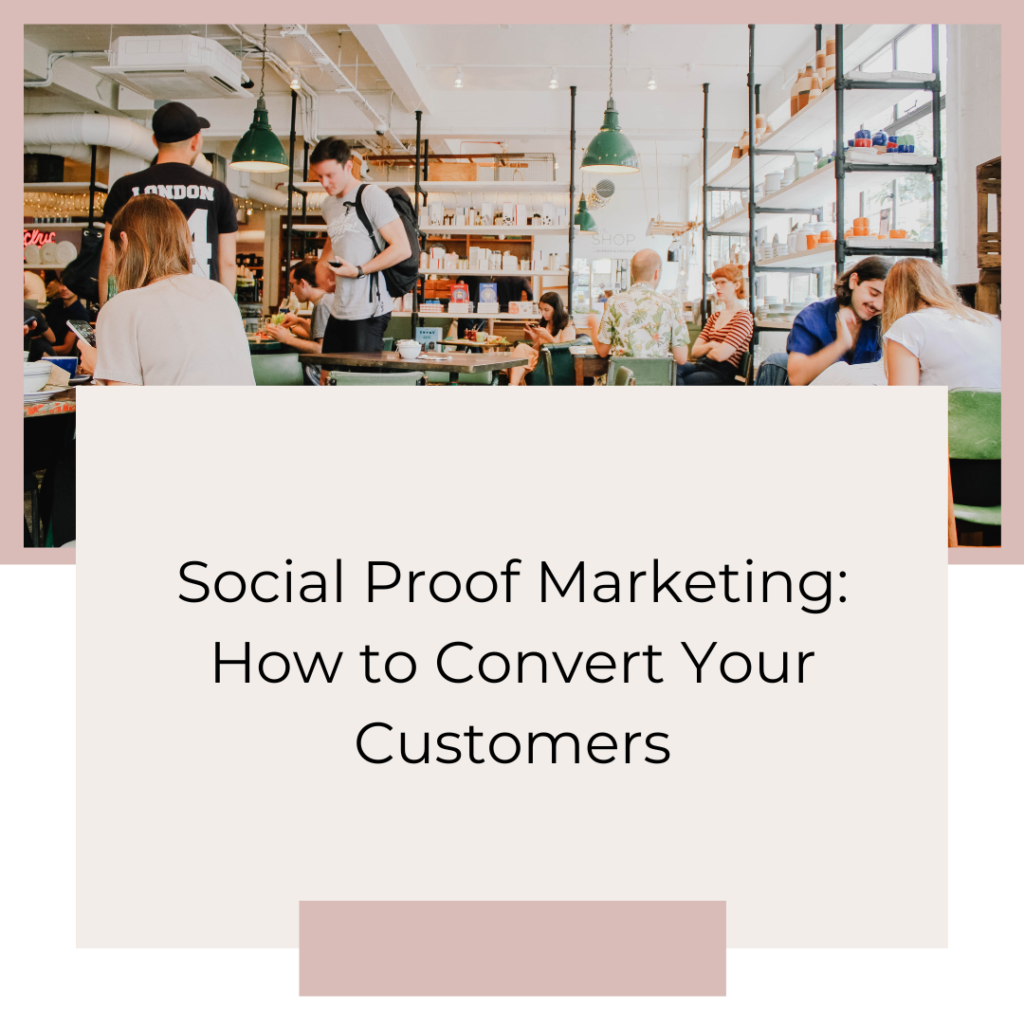Social Proof Marketing: How to Convert Your Customers

Social proof marketing helps you convert your customers and increase sales. But it can seem complicated to execute. In this article I will break down the psychology behind social proof in marketing. And provide you with the best tips on how to incorporate social proof in your marketing.
Why is social proof marketing important?
Social proof marketing is important for your business because its signals trust to your customers. It validates that your customers are making the right choice, which will make them complete the purchase of your product.
Keep reading to learn what social proof is and how to use it to elevate your marketing.
In the article, we will cover:
What is social proof?
The concept of social proof is based on the principle that people follow the lead of others like them. Humans are social beings and rely on people around them when it comes to how we think, feel and act. We want to feel like we belong and need confirmation of other people to make us feel like we belong. Therefore, when it comes to buying decision we rely on other people’s behavior to make our own decision. If many other people bought a product that must mean it is good, right? And if it turns out the product is not good, then at least we are not alone in our bad decision.
This is the principle of social proof in marketing. Using other customers to convince new customers to buy our products or services. Social proof is a way of using peer pressure in marketing. Before we get into how to use social proof in marketing, make sure you know your marketing basics. Because social proof is most effective when used in combination with other marketing techniques. Read more about the basics of marketing in this article about Marketing for a Small Business.
Why use social proof in marketing?
You now know that other people affect how we buy. But why is it a good technique in marketing?
Except for the pure peer pressure that social proof can have in marketing, social proof also signals trust. And trust is an important factor for consumers when making buying decisions. People, in general, are risk averse, meaning that they don’t like taking risks. Every time a consumer buys something new, they are taking the risk that it is not a good purchase.
Using social proof as a way of signaling trust makes the consumers believe that they are taking less risk. Having other people validating the consumer by confirming that the product is a good choice, makes the consumer less uncertain. Therefore, they are more likely to buy the product.
Social proof used in marketing is thus a great way to signal trust and increase the likelihood of new customers completing a purchase.
The psychology behind social proof marketing
Social proof can work both positively and negatively in marketing. While social proof used deliberately in marketing signals trust. It can also cause consumers to defer from a purchase. If a product has negative reviews for example, that will stop consumers from buying the product. Therefore, it is important to understand the psychological forces behind social proof. To ensure you are using positive social proof and avoiding negative social proof.
There are several ways other people affect our decisions, which are outlined below.
Compatibility in social proof marketing
It is in our psychology to like other people who are similar to ourselves. We are compatible with people are like us. Compatibility in social proof means that consumers will be more inclined to believe other customers who are similar to themselves. A strategy for using social proof in your marketing is thus to attract similar customers.
You can do this by having a target audience of similar individuals. And highlighting the characteristics that are the same throughout your target audience. An easy way to do this is by creating a customer profile or buyer persona for your target audience. This helps to display the similarities that your target audience share. If you don’t have your target audience defined yet you should first check out this article about Target Market Analysis.
Compatibility can also be used to create friendships amongst customers – or communities. The community that shares common interests or values will work as a form of social proof. In addition, your community will also function as a marketing channel for your products. Where customers share tips and reviews that promotes your products.
But compatibility does not only include people who are similar. It can also be aspirational compatibility – meaning that people want to be part of a certain group. Or want to be connected to a certain person or type of person. Aspirational compatibility includes the advice from celebrities, influencers or role models. Which also counts as a type of social proof. In this case one person’s opinion weighs heavier because of their position of influence.
Number of customers present
The sheer number of other customers that are present influences how a person buys. If there are many other people doing the same thing, it signals that it is a good thing. Therefore, more people will be inclined to do that thing. On the other hand, if there are too many people it might deter consumers as well.
For example if there are too long lines, or too crowded to go in to a store. At the same time, you don’t want there to be no other people present because then the consumer will feel odd and displaced. For example you wouldn’t want to eat in an empty restaurant at peak hour, because it signals that it is a bad restaurant.
Thus, there is a fine balance when it comes to the number of other customers present. However, more customers is always better than less, because it gives social proof and signals trust.
Waiting times as social proof
In general waiting times reduce customer satisfaction and has a negative effect on sales. Long lines, with long waiting times are therefore usually something to avoid. However, lines and waiting times can sometimes work as social proof. Especially when a ‘hype’ is created around a product or brand. For example of there are lines to enter a store, it draws attention and signals that it is popular. Therefore, more people will want to enter the store.
But just like in the previous example, there is a fine balance and you do not want a line become too long. Because then the waiting time is too long for consumers to be part of the hype. Waiting times can also be used through reservations. By having a limited amounts of spots or products, you can create a waiting time by taking reservations. A long waiting time then serves as social proof that the offer is popular, which will increase the want for the offer.
Type of other customers
The type of other customers present can both work as positive and negative social proof. Individuals have preferences about groups of people they want to be part of and that they want to avoid. We also have detailed assumptions about what these groups buy. If a person from a group that the consumer wants to belong to is present, it will serve as positive social proof.
However, the opposite is true if a person from a group the consumer does not want to associate with is present. Then the consumer will not want to buy the product. And the presence of the other customer will serve as negative social proof. It is important to know what types of groups your target audience wants to associate with. You want to make sure they receive the right influence during their experience with your brand. Yet, it is also important to note that these assumptions about groups can be based on prejudices.
Social proof comes in many shapes and forms. Understanding these psychological influences behind the concept is vital for using social proof marketing.
How to use social proof marketing
Social proof works in all settings – or all marketing and sales channels. While it might be easier to imagine social proof marketing used in physical stores where you can see other people. Social proof works just as well, if not better, online.
Now, let’s get into how to actually use social proof in marketing, across different channels.
Social proof in physical locations
Social proof in brick-and-mortar stores can be challenging to create. Despite it being the channel where customers meet each other. Because in a physical location you cannot control how your customers act or who comes into your store. However, there are a few ways to still create social proof in your physical store:
- Create crowds; by creating special events in your store you can attract more people to visit your store. This can create crowds and lines that draws attention to your store. You can also make people sign up in advance to an event in your store, creating more of a ‘hype’ around it.
- Hiring sales staff that are similar to your customers. People follow the lead of similar others. Therefore, if the staff in your store are similar to your customers, your customers will feel like they are representative of the business. Thus, creating social proof. Having your staff wear clothes from your store for example, is a great way to create social proof that the garments are good.
- User generated content in store. Who says that user generated content only has to be online? You can use customer testimonials, reviews or even photos in your store. For example you can use quotes from your customers as part of the interior design of your store. Either by printing it on your walls or using it in paintings. Or you can put customer reviews and customer’s own photos on digital displays. Of course make sure you have permission from your customers!
Social proof on social media
There’s a reason they call it social media – because it’s social. Social proof is therefore very easy to incorporate in your social media. Your social media channels basically serve as social proof by themselves. If your business has many followers it signals that other people likes it and thus it acts as social proof. But there are many more ways to incorporate social proof into your social media, even if you don’t have that many followers (yet!):
- Reviews and testimonials in your posts. Reviews or testimonials from customers in text form is the easiest way to integrate social proof in your social media posts. If you want to level up, you can ask your top customers to be part of your posts by using testimonial videos.
- User generated content. Another way is to use your customers’ photos or videos on your social media page. Encourage your customers to post when they are using your products, then choose the best posts and repost it on your own social media.
- Creating a community around your business or brand is a great way to create social proof. Through social media the easiest way is to create Facebook groups. But you can create communities through other social platforms as well by engaging with your followers. To learn more about creating engagement, you should read this article on how to create Social media engagement posts.
- Influencer marketing is almost a category of its own since it is a large industry by itself. But using influencers to promote your products can be a great way to create social proof. It does not need to be influencers with hundreds of thousands of followers – they will be very expensive. Using micro or nano influencers can be even more effective and is a great way to promote your products.
Social media is one of the best and easiest ways to create social proof. For more tips on how to grow and develop your social media, read this article on Small Business Social Media Marketing.
Social proof on your website
Using social proof on your website or ecommerce store can seem more challenging. Because a website is not inherently social. But there are still many ways to create social proof on your website. Although some might require more advanced technical skills.
- Reviews and testimonials are the easiest way to incorporate social proof in any channel. Reviews of your products online is one of the most important factors when customers decide whether to buy your product. But they need to be real and honest. Therefore, you need to ensure you only sell good quality products. To make sure you get positive reviews. If you sell services or B2B offers you can also include testimonials in quotes or videos on your website.
- User generated content. Again, user generated content can be integrated on your website by embedding customers’ social media posts. Or ask customers to post pictures/videos that you include in your product photos or elsewhere on your website.
- Other customers’ behavior. This part might require a bit more technical skills to incorporate in your ecommerce store. But it works as a great way to provide social proof. You can include messages about how other customers behave on your site. Such as how many other customers are looking at a particular product, or bought it within the last hour. You can have pop-up messages saying “10 other people looking at this product”. Or “5 customers bought this within the last 10 minutes”. You can also use messages about how many products you have in left stock. That is a common tactic for hotel sites, where they announce that there are only a few rooms left. Which signals popularity and provides social proof. Another strategy is to suggest other products that customers bought when looking at a particular product. That signals social proof in the sense that other customers bought the product and they bought other products to go with it.
There are many more ways to create social proof online, on social media and in your physical store. But these examples hopefully provided you with some tips and inspiration on how to use social proof marketing.
As human beings we like to get validation of our thoughts, behavior and feelings. And that includes what, when and where we buy. Social proof marketing is a useful technique to incorporate to provide trust to your customers. And it will help you make more sales.
Remember there are many ways to create social proof in your different sales and marketing channels. But a few of them are:
- Attracting crowds and creating hypes
- Hiring sales staff that are your target audience
- User generated content
- Reviews and testimonials
- Creating communities
- Influencer marketing
- Providing tips or behavior from other customers
I hope you enjoyed this article on how to use social proof in your marketing. And that you found some useful tips that you can start incorporating today! Make sure to share the article with a friend or coworker that would benefit from it.
If you liked this article you might also like:

I'm Emma Ellinor
I’m a digital marketer, project manager and retail analyst.
For the past 7 years I have immersed myself into the field of marketing and management. I am on a mission to inspire more women to take their business to the next level. By sharing my journey to escape the 9-5 trap along with useful marketing, time management and small business tips.
